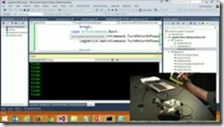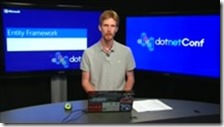We just wanted to say thank you for your time attending the dotnetConf in June 2014 where we shared innovation and news about the present and future of .NET, all in a single place focusing on .NET technologies.
You may have missed sessions during the streaming delivered on June 25th and 26th, so, for your convenience, we’d like to remind that all the sessions at the dotnetConf were recorded and are available here:
https://channel9.msdn.com/Events/dotnetConf/2014
The dotnetConf 2014 was a two-day virtual event (June 25th-26th) focused on .NET technologies, covering application development for the desktop, mobile and cloud/server. It is hosted by the MVP community and Microsoft, bringing top speakers and great topics straight to your PC.
Below you can review all the delivered sessions and reach to their related recorded content.
Day 1 – .NET core and .NET in client/devices
|
Opening and overview of current .NET state and .NET on the Client side. |
|
|
New Innovations in .NET Runtime We’re changing the way we execute code in the .NET Runtime. Hear about .NET Native, RyuJIT, and modern server strategy. |
|
|
Kevin Pilch-Bisson, Mads Torgersen The Microsoft Managed Languages team has been focused on rebuilding the VB and C# compilers and editing experiences as part of Project "Roslyn". This effort has paved the way for these languages to continue evolving for many years to come. However, what does that future actually look like? We explore the editing experience, how public APIs may be used to write language-level extensions, as well as new language features. |
|
|
Building Universal Windows Apps with XAML and C# in Visual Studio In April at Build 2014, Microsoft unveiled universal Windows apps, a new approach that enables developers to maximize their ability to deliver outstanding application experiences across Windows PCs, laptops, tablets, and Windows Phones. This means it’s now easier than ever to create apps that share most of their code. Code can be shared using the new shared app templates, as well as by creating Portable class libraries. This session will walk through the development of a shared app and will discuss where it still makes sense to implement platform specific features. |
|
|
Look inside the .NET Native compiler toolchain to understand how we enable .NET Windows Store apps to compile to self-contained native apps. |
|
|
Fun with .NET – Windows Phone, LEGO Mindstorms, and Azure In this demo-packed session, we’ll walk through building your first .NET controlled LEGO Mindstorm using Windows Phone. You’ll learn about the LEGO EV3 API, how to control motors and read sensor data, and how to batch commands to the robot. Once we have a working, drivable robot, we’ll switch to cloud-enabling the robot so that you can drive the robot remotely via a Web site hosted in Microsoft Azure. |
|
|
We will take a look at what’s new in Kinect for Windows v2 including the improvements in core sources like Infrared and Depth data. We will also show how the new Kinect Studio enables Kinect development even while travelling via plane, train, or automobile (note: you should not dev and drive) and how Kinect Interactions can be used to add a new input modality to Windows Store applications. |
|
|
What’s New in XAML Platform & Tooling Tim will do a lap around what is new to the Windows Phone 8.1 platform as well as a tour of the new XAML tooling in Visual Studio Update 2 for developers and designers. |
|
|
Developing Native iOS, Android, and Windows Apps with Xamarin James Montemagmo (Xamarin) Mobile continues to expand and evolve at a rapid pace. Users expect great native experiences in the palm of their hands on each and every platform. A major hurdle for developers today is that each platform has its own programming language and tools to learn and maintain. Even if you tackle the burden of learning Objective-C and Java you will still have to manage multiple code bases, which can be a nightmare for any development team large or small. It doesn’t have to be this way as you can create Android, iOS, Windows Phone, and Windows Store apps leveraging the .NET framework and everything you love about C#. |
|
|
Windows Presentation Foundation (WPF) enables .NET developers to build rich and powerful Windows desktop applications using managed languages and XAML. In this session we’ll cover all the latest innovations available to WPF developers such as improvements coming from .NET, integration points with the latest cloud technologies and enhanced tooling & profiling capabilities in Visual Studio. |
Day 2 – .NET in server and cloud
|
ASP.NET Today and Tomorrow (Keynote) It’s been an amazing decade for ASP.NET. Today in 2014, most all of ASP.NET is open source, developed in the open, and accepting community contributions. One ASP.NET and VS 2013 added some amazing new tooling enhancements for HTML5, CSS3 and JavaScript. VS2013.3 is coming soon with even more innovations as we march towards ASP.NET vNext. Join Scott Hunter as he shows you how it works together. What’s available on ASP.NET today, and where is ASP.NET headed tomorrow, and what do you need to know to best support the code you’ve written and the code you will write. We’ll also talk about the rise of the cloud and how it changes the way we write large systems. All this, plus a lot of open source, and deploying to Azure. |
|
|
Do you want to learn techniques to enhance your Web Forms development experience. See how you can improve your code’s maintainability and testability and your site’s performance. Leverage new features in ASP.NET Web Forms 4.5 to reduce the amount of UI "yuck" code and focus on your application’s logic. We will look at some of the improvements to Web Forms such as support for EF 6, new Scaffolders and more features which you might not have heard of. We will see how to leverage all of the latest tools in Visual Studio like Browser Link and Web Essentials to make their coding experience simpler, shorter, and more enjoyable. |
|
|
ASP.NET MVC 6 (now with integrated Web API!) ASP.NET MVC and ASP.NET Web API in ASP.NET vNext are becoming one singular framework: ASP.NET MVC 6. Join Daniel Roth as he shows how to create great ASP.NET web apps that serve both pages and services. First we’ll see how to build OData v4 compliant services using ASP.NET Web API 2.2 and the new attribute routing features available in ASP.NET MVC 5.2. Then we’ll take a look at how ASP.NET MVC and Web API are being combined into a single framework, ASP.NET MVC 6, for handling all of your Web UI and services. We’ll learn how to use ASP.NET MVC and Web APIs in ASP.NET vNext to support connected applications for browsers, Windows Phone, Windows Store and more! |
|
|
Entity Framework (v6 and v7 preview) Entity Framework is Microsoft’s recommended data access technology for new applications in .NET. We’ll explore how the current release of Entity Framework can be used to build applications. We’ll also look at an early preview of EF7, a modern, lighter weight, and composable version of Entity Framework (EF) that can be used on a variety of platforms, including ASP.NET vNext, Windows Phone and Windows Store. This new version will also support targeting non-relational data stores. |
|
|
Taking Your ASP.NET Apps to the Cloud with Microsoft Azure Web Sites Web developers are seeing huge boosts in their productivity building Web Applications with ASP.NET, with so many huge improvements to Visual Studio focused on the problems web developers solve each day. We’ve also made some significant improvements in Microsoft Azure for web developers by concentrating on providing the community the best cloud in which to host ASP.NET web apps. Features like Auto-scaling and Traffic Management provide high-performance, internationally-distributed web hosting scenarios. We’ve made it easier than ever to add background processing by adding Azure WebJobs as an option for web developers who need to add a middle tier. Along with staging and production deployment slots, and a rich SDK to enable service automation – a feature many software-as-a-service apps can use to automate their provisioning and deployment experiences – there’s no better place than Microsoft Azure Web Sites to host your ASP.NET apps. |
|
|
The Visual Studio publishing experience for ASP.NET projects has been refined over the past few years. In this talk we will go into detail covering all the different techniques to publish your asp.net apps. We will start in Visual Studio, and quickly move to the command line and continuous integration servers. Sayed will you how you can improve your publish process to target multiple environments and how to automate publishing from a CI server. We will also take a look at some of the unique publish workflows that Azure Web Sites supports. |
|
|
ASP.NET Identity is a totally rewritten framework that brings the ASP.NET membership system into the modern era. ASP.NET Identity makes it easier to integrate different authentication systems such as local username, password as well as social logins such as Facebook, Twitter etc. It also gives you greater control over persisting data to your backend technology of choice. ASP.NET Identity is a game changer by bringing in more modern authentication systems such as Two-Factor Authentication. You can use ASP.NET Identity to secure Web Apps as well as Web APIs.
|
|
|
Dependency Injection and Testability in .NET Mani Subramanian, Francis Cheung Testability is more important than ever. With short ship cycles and the desire for continuous delivery, it is critical to quickly know if a modification has destabilized your code base. This session will enable you to use a dependency injection container of your choice to create testable code. We will examine tightly coupled code and what problems it causes and how DI can be used to avoid these problems. The Unity DI container will be used as the medium to understand the concepts.
|
|
|
SignalR is one of the latest additions to the ASP.NET web stack. It provides real-time HTTP support for your web applications, but the good news is that SignalR is useful outside of a web browser, too. With a client API that’s virtually identical in both the JavaScript and native .NET client implementations, developers only need to learn the SignalR abstraction itself to be able to write cross-platform real-time applications. This session will walk through the process of adding real-time functionality to your Windows 8 and Windows Phone 8 apps. We’ll also take a look at the scale-out providers and OWIN hosting capabilities available in the latest release of SignalR. |
|
|
ASP.NET vNext is a lean and composable framework for building web and cloud applications. ASP.NET vNext is fully open source and available on GitHub. ASP.NET vNext is currently in preview, and in this talk Fowler and Edwards will put it all into Context. vNext apps can use a cloud-optimized subset of the .NET framework. This subset of the framework is about 11 megabytes in size compared to 200 megabytes for the full framework, and is composed of a collection of NuGet packages. What does that mean for compatibility? When would you choose vNext and when would you not? You don’t have to use Visual Studio to develop ASP.NET vNext applications. You can develop and run vNext on platforms that Visual Studio doesn’t run on. But Visual Studio provides the best development experience, and we’ll cover ASP.NET vNext both inside and outside the IDE. |
We encourage you to share this content with your colleagues and friends, while highlighting that all the dotnetConf recorded content is free to access!
Finally, we’d excited to announce that we’re planning another dotnetConf to be happening in a few months, so keep tuned thru the dotnetConf Twitter account (@dnetconf), or checking our dotnetConf site in the future.
Sincerely,
The dotnetConf team.























0 comments